Human Orbital Spaceflights
![]()
International Flight No. 192Soyuz TM-25SiriusRussia |
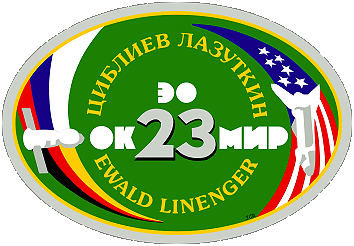 |
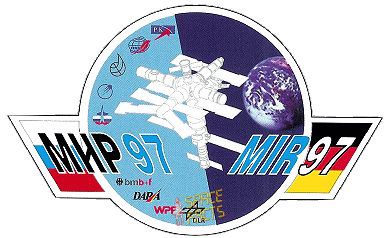 |
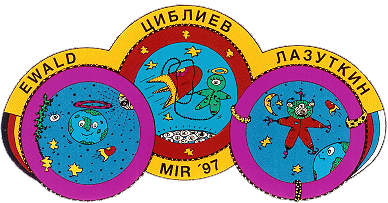 |
||
![]()
Launch, orbit and landing data
walkout photo |
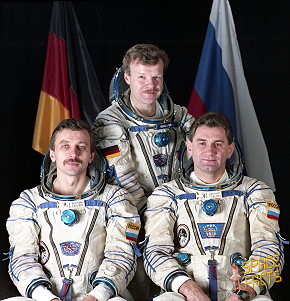 |
|||||||||||||||||||||||
alternative crew photo |
alternative crew photo |
|||||||||||||||||||||||
alternative crew photo |
alternative crew photo |
|||||||||||||||||||||||
alternative crew photo |
||||||||||||||||||||||||
Crew
| No. | Surname | Given names | Position | Flight No. | Duration | Orbits | |
| 1 | Tsibliyev | Vasili Vasiliyevich | Commander | 2 | 184d 22h 07m 41s | 2926 | |
| 2 | Lazutkin | Aleksandr Ivanovich | Flight Engineer | 1 | 184d 22h 07m 41s | 2926 | |
| 3 | Ewald | Reinhold | Research Cosmonaut | 1 | 19d 16h 34m 46s | 311 |
Crew seating arrangement
|
 |
|
||||||||||||||||
Backup Crew
|
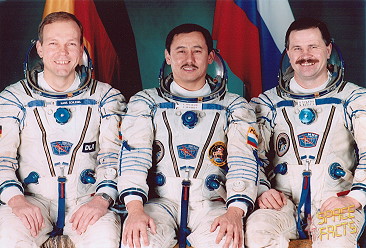 |
||||||||||||||||||||
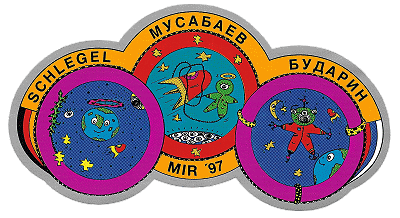 |
alternative crew photo |
||||||||||||||||||||
Hardware
| Launch vehicle: | Soyuz-U (No. Kh15000-650) |
| Spacecraft: | Soyuz TM-25 (7K-STM No. 74) |
Flight
|
Launch from the Baikonur Cosmodrome and
landing 189 km southeast of Dzheskasgan. The current Mir-23 mission began when cosmonauts Vasili Tsibliyev and Aleksandr Lazutkin and German Research Cosmonaut Reinhold Ewald of DARA (mission EuroMir 97) were launched on February 10, 1997, in Soyuz TM-25 and docked with the Mir two days later. Within meters of automatic approach to the station, a slight misalignment was noted, and the Commander of the module had to dock it by manual steering. Reinhold Ewald amused himself well on-board of the Mir space station. He used as his private domain the module Kristall. His American colleague Jerry Linenger had his private quarter in the Module Spektr. He was sleeping there, had room for personal belongings and he found a free surface on the wall to fasten some photographs. Reinhold Ewald discussed the experiments which he had to execute during this mission with Sigmund Jähn (at TsUP) or with his backup Hans Schlegel (in GSOC). Reinhold Ewald was successfully executing the program although now and then something went wrong. In the framework of a medical experiment he had to drink 200 ml tomato-juice with salt, but bad quality of the juice made this impossible. The experiments with the Titus-oven, the French Alice-2 installation (studies of the characteristics of liquids) and MEDEX (medical experiments) were successfully executed. Jerry Linenger began his stay on the orbiting Russian facility with the Mir-22 crew in mid-January with the docking of STS-81. He became a member of the Mir-23 crew and continued his science investigations when the Mir-22 crew and Reinhold Ewald returned to Earth on March 02, 1997 with Soyuz TM-24 spacecraft. After Jerry Linenger and Michael Foale completed their handover, Michael Foale worked with the Mir-23 crew until the arrival of Mir-24 cosmonauts Anatoli Soloviyov and Pavel Vinogradov with Soyuz TM-26 in August 1997. After the Mir-23 crew returned to Earth in Soyuz TM-25, Michael Foale completed his tour with the Mir-24 crew. The return of Atlantis on STS 84 concluded some experiments, continued others and commenced still others. Data gained from the mission will supply insight for the planning and development of the International Space Station, Earth-based sciences of human and biological processes, and the advancement of commercial technology. The research program conducted by Michael Foale featured 35 investigations total (33 on Mir, two on STS 84, and another preflight/postflight) in six disciplines: advanced technology, Earth observations and remote sensing, fundamental biology, human life sciences, space station risk mitigation, and microgravity sciences. Twenty-eight of these were conducted during previous missions and were to be continued, repeated or completed during Michael Foale's stay. Seven new experiments were planned in biological and crystal growth studies and materials processing. Earth sciences research in ocean biochemistry, land surface hydrology, meteorology, and atmospheric physics and chemistry also were performed. Observation and documentation of transient natural and human-induced changes were accomplished with the use of passive microwave radiometers, a visible region spectrometer, a side-looking radar, and hand-held photography. Earth orbit allowed for documentation of atmospheric conditions, ecological and unpredictable events, and seasonal changes over long time periods. Fundamental biology research continued developmental investigations that study the effects of the space environment on the biological systems of plants. Prolonged exposure to microgravity provides an ideal opportunity to determine the role gravity has on cell regulation and how this affects development and growth. Investigations under this discipline will also characterize the internal radiation environment of the Mir space station. Human life sciences research consisted of investigations that focus on the crewmember's adaptation to weightlessness in terms of skeletal muscle and bone changes, psychological interactions, immune system function, and metabolism. In addition, environmental factors such as water quality, air quality, surface assessment for microbes, and crew microbiology were assessed. These ambitious investigations continued the characterization of the integrated human responses to a prolonged presence in space. Space science research continued with the externally mounted Mir Sample Return Experiment (MSRE) and Particle Impact Experiment (PIE) payloads. These experiments continued to collect interstellar and interplanetary space particles to further our understanding of the origin and evolution of planetary systems and life on Earth. Environmental Radiation Measurements: Exposure of crew, equipment, and experiments to the ambient space radiation environment in low Earth orbit poses one of the most significant problems to long term space habitation. As part of the collaborative NASA/Mir Science program, a series of measurements were compiled of the ionizing radiation levels aboard Mir. During the mission, radiation was measured in six separate locations throughout the Mir using a variety of passive radiation detectors. This experiment continued on later missions, where measurements will be used to map the ionizing radiation environment of Mir. These measurements will yield detailed information on spacecraft shielding in the 51.6-degree-orbit of the Mir. Comparisons were made with predictions from space environment and radiation transport models. Greenhouse-Integrated Plant Experiments: The microgravity environment of the Mir space station provided researchers an outstanding opportunity to study the effects of gravity on plants, specifically dwarf wheat. The greenhouse experiment determined the effects of space flight on plant growth, reproduction, metabolism, and production. By studying the chemical, biochemical, and structural changes in plant tissues, researchers hoped to understand how processes such as photosynthesis, respiration, transpiration, stomatal conductance, and water use are affected by the space station environment. This study was an important area of research, due to the fact that plants could eventually be a major contributor to life support systems for space flight. Plants produce oxygen and food, while eliminating carbon dioxide and excess humidity from the environment. These functions are vital for sustaining life in a closed environment such as the Mir or the International Space Station. Human Life Sciences: The task of safely keeping men and women in space for long durations, whether they are doing research in Earth orbit or exploring other planets in our solar system, requires continued improvement in our understanding of the effects of space flight factors on the ways humans live and work. The Human Life Sciences (HLS) project had a set of investigations planned for the Mir-24/NASA 5 mission to determine how the body adapts to weightlessness and other space flight factors, including the psychological and microbiological aspects of a confined environment and how they readapt to Earth's gravitational forces. The results of these investigations will guide the development of ways to minimize any negative effects so that crewmembers can remain healthy and efficient during long flights, as well as after their return to Earth. Protein Crystal Growth (PCG) experiments were conducted in three facilities - the Gaseous Nitrogen Dewar (GND) facility, the Diffusion-Controlled Crystallization Apparatus for Microgravity (DCAM) facility and the Second-Generation Vapor Diffusion Apparatus (VDA-2) facility. On February 24, 1997 an oxygen cartridge caught fire and a grey smoke spread out in all parts of the complex. Valeri Korzun and Aleksandr Kaleri fought against the fire with extinguishers and the others tried to push back the smoke. All crew members had to wear gas-masks. This lasted two and a half hours the maximum endurance of those masks. The extinction water caused a high humidity and the temperature of the atmosphere was higher than normal. Reinhold Ewald did not get smoke or just a little bit in his longs and to remain on the safe side he swallowed coal- and vitamin tablets and milk products. He was very tired but he did not think that this had been caused by something like pollution, but by the lack of sleep. Jerry Linenger was very busy collecting air samples for pollution tests. He also tried to determine the amount of formaldehyde. The crew of six was in the Base Block when the fire began in an adjacent room. Russian toxicologists are analyzing telemetric data about Mir's on-board atmosphere. The crew already collected urine- and saliva samples and later on they got instructions to collect blood samples and to do additional medical tests. The fire lasted 14 minutes and meter-long flames of burning lithium perchlorate in the Kvant module blocked the way to one of the two Soyuz spaceships. Valeri Korzun, Aleksandr Kaleri and Reinhold Ewald undocked from Mir in the Soyuz TM-24 spaceship at 03:24 UTC on March 02, 1997 and landed at 06:44 UTC in Kazakhstan. On March 04, 1997 the redocking of freighter Progress M-33 at the Mir complex planned for at 07:50 UTC did not take place. Vasili Tsibliyev reported that the Progress M-33 did not do what she had to do and that he did not have a continuous image on his screen of the approaching ship. So, he was unable to aim her with the system TORU. He was able to give some commands, for instance to reduce the speed of Progress M-33. Progress M-33 passed Mir in a distance of 220 - 230 meters. The cosmonauts now and then had visual observations of the Progress M-33, but not continuously and it was difficult to determine the distances via the portholes as there were no reference points. Progress M-33 was flying near Mir in a distance of 1 kilometer. On March 05, 1997 one of the Elektrons (possibly the 2nd Elektron was out of order and had to be repaired with spare parts to be delivered by the next supply ship) showed a malfunction and so the crew had to use a part of the oxygen reserved for spacewalks to bridge the period until the repair of that Electron. They managed to get this Elektron operational again afternoon. The crew was very busy to secure the working of the life. Among the additional measures to maintain a liveable situation on-board a lot of air hoses had been deployed to enhance the air circulation through the whole complex. It has been decided not to try a second attempt to redock Progress M-33 at Mir. The Progress M-33 was put on a destruction course and burned up in the atmosphere over a designated area in the Pacific East of New Zealand. The Progress M-34 was launched from Baikonur on April 06, 1997 at 16:04:05 UTC. Progress M-34 had to deliver new supplies of fuel, oxygen, water, food and repair materials. Progress M-34 also brought two spacesuits for spacewalks (EVA's) of a new type. Originally the Russians planned to have a new Antares transmitter (for communications via the geostationary satellite) ready for the flight with Progress M-34, but possibly they could make that and that means that this transmitter will be delivered at Mir by the shuttle Atlantis in May 1997. The vessel docked with Mir at the rear Kvant module port on April 08, 1997 17:30:03 UTC. The Mir complex raised its orbit by 5 km on April 15, 1997 at 12:00 UTC, using Progress M-34's engine. Immediately after the opening of the hatches to Progress M-34 the crew began to unload the most important stuff for direct use. They used a part of the new arrived pure oxygen supply and new lithium perchlorate 'disks' for oxygen production. Radio traffic revealed that the cosmonauts without delay had started the repair of the Elektron system in Module-D (Kvant2). On April 11, 1997 this Elektron was activated, but after a few minutes during which oxygen was produced it switched itself off. On the days to follow the crew regularly worked on this system and to undo the last failure they even used a part of the unserviceable Elektron in Module-E (Kvant1). The urgent work on the Elektron caused a considerable work overload of the crew. These days the astronaut Jerry Linenger was often deployed to assist in this repair work for which he had to refrain from a part of his American experiments. A few times the work on the Elektron had to be suspended for the execution of repair work with a higher priority. This had to do with a lot of leakage in the heating- and cooling circuits in the Base Block and Kvant1. The leaks in the cooling loops in Kvant1 caused the outflow of cooling liquid (ethylene glycol) and the decrease of the pressure within that circuit. A sufficient cooling is also needed for the functioning of the carbon dioxide (CO2) absorber Vozdukh. For the neutralization of CO2 in Mir's atmosphere there was another alternative. Progress M-34 delivered for that purpose canisters lithium hydroxide. Meanwhile the Elektron in Kvant2 and the Vozdukh CO2 scrubber were functioning. The problems with the life support systems on-board caused a high humidity and consequently a lot of condensation. Twice a day Vasili Tsibliyev could be heard reporting pulse rates, blood pressures, skin temperatures and blood oxygen saturation of all crew members. The only EVA by Vasili Tsibliyev and Jerry Linenger occurred on April 29, 1997 (4h 59m). They retrieved some sample collection experiments from the outside of the complex. These tasks consisted of the installation of the OPM (Optical Properties Monitor) at the outer surface of the SO (docking compartment at the Kristall module). Having this done they moved by the crane Strela to the Kvant2 where they retrieved the American experiments PIE (Partial Impact Experiment) and the MSE (Mir Sample Experiment). These experiments were brought back to earth by the Atlantis in May 1997. The last task was the installation on Kvant2 of the Benton Radiation Dosimeter. This instrument measured the intensity of the radiation between 51.6° North and 51.6° South. The areas between these latitudes were covered by the IRS, which orbited in the same inclination (51.6°) as Mir. During radio windows they worked with tranquillizing music in the background. Radio traffic revealed that Vasili Tsibliyev and Jerry Linenger had a lot of fun and acted fully relaxed. The EVA was successful and they did not meet any problems. The new type of the Orlan DMA spacesuit was used for the first time and Vasili Tsibliyev reported his satisfaction about the improvements. He told that his good experience with this spacesuit during training in the hydrolab now has been proven in practice. The suit is very flexible, and especially the gloves are very good: it is much easier to use your fingers. Vasili Tsibliyev had the right to judge this for he did 5 EVA's during his mission in 1993. During the EVA Aleksandr Lazutkin remained on-board where he watched the systems, made films of his colleagues, helped them with advice and communications. Space Shuttle STS 84 docked with Mir space station on May 17, 1997. This was the sixth of nine planned missions to Mir and the third one involving an exchange of U.S. astronauts. Astronaut Jerry Linenger, who was on Mir since January 15, 1997, was replaced by astronaut Michael Foale. He spent more than four months on Mir. He returned to Earth on Space Shuttle Mission STS-86, launched in September 1997. Atlantis again carried the SPACEHAB module in the payload bay of the orbiter. The double module configuration housed experiments to be performed by Atlantis' crew along with logistics equipment to be transferred to Mir. STS 84 docking with Mir occurred on May 17, 1997 at 02:33 UTC above the Adriatic Sea. Hatches between two spacecraft opened at 08:25 UTC, May 17, 1997. Greetings exchanged between STS 84 crew and Mir-23 Commander Vasili Tsibliyev, Flight Engineer Aleksandr Lazutkin and Jerry Linenger, followed by a safety briefing. Jerry Linenger and Michael Foale officially traded places at 14:15 UTC. STS 84 involved the transfer of 3,318 kilograms (7,310 lb) of water and logistics to and from the Mir. During the docked phase, 465 kilograms (1,030 lb) of water, 383.2 kilograms (845 lb) of U.S. science equipment, 1,168.6 kilograms (2,576 lb) of Russian logistics along with 178.1 kilograms (393 lb) of miscellaneous material were transferred to Mir. Returning to Earth aboard Atlantis were 407.1 kilograms (898 lb) of U.S. science material, 531.2 kilograms (1,171 lb) of Russian logistics, 14 kilograms (31 lb) of ESA material and 170.7 kilograms (376 lb) of miscellaneous material. Transfer of items to and from Mir proceeded smoothly and was completed ahead of schedule. One of first items transferred to station was an Elektron oxygen-generating unit. Altogether about 249 items were moved between the two spacecraft, and about 450 kilograms (990 lb) of water moved to Mir, for a total of about 3,400 kilograms (7,500 lb) of water, experiment samples, supplies and hardware. For the STS 84 mission, Atlantis backed away from Mir on May 22, 1997 until it reached a distance of 3,000 feet (914.4 meters) below the Mir in order to test a European laser docking sensor. Unlike previous Shuttle-Mir flights, there was no fly-around of the station for photo documentation. When Atlantis reached the 3,000-foot (914.4 meters) distance, instead of firing jet thrusters to perform a separation maneuver, the Shuttle depended on the natural forces of one spacecraft being in a lower orbit than another which will cause the Shuttle to move ahead of the Mir. New ESA-developed technology was tested during the Shuttle's approach and departure from Mir. A GPS receiver and an optical rendezvous sensor on the Shuttle, together with equipment already installed on Mir, were operated for the first time in space in an enactment of how ESAs unmanned Automated Transfer Vehicle (ATV) will approach and depart the International Space Station when it delivers supplies to it early in the next century. During the long-range approach to Mir (starting 3 hours before docking), ESAs European Proximity Operations Sensor GPS receivers on Atlantis and Mir received data from Navstar Global Positioning Satellites on the position of the other craft. The accuracy of that relative navigational data was later compared with true data from the Shuttles rendezvous radar. When the Shuttle was at 170 feet (51.8 meters) from Mir, the short-range experiment began. Navigation was handed over to the optical rendezvous sensor. Data again were later be compared to true figures, this time supplied by the NASA Trajectory Control System (TCS), a laser ranging device in the payload bay. The robot cargo ship Progress M-34 undocked from Mir at 10:22 UTC on June 24, 1997 to perform a redocking test using recently developed remote-control procedures which are replacing the old automatic systems that Russia can no longer afford to buy from Ukraine. At 09:10 UTC on June 25, 1997, Mir Commander Tsibliyev was remotely commanding the approach of Progress to the Kvant (37KE) module when the Progress went off course and collided with a solar array on the Spektr module and then the module itself. A large hole was made in the solar panel, and one of Spektr's radiators was badly buckled. A small breach in Spektr's hull appears to have been made and the module began to depressurize. This was not a slow leak - the crew heard a hissing sound and felt their ears pop. They closed the hatch on the core module transfer section that leads to Spektr by 09:38 UTC. The Spektr module was thereafter fully depressurized. It remains docked to Mir with its docking hatch open. The electrical connection between Spektr's solar panels and the main station was broken off, also cutting off the power supply from the solar panels on the Kristall module. The crew sealed the hatch to the leaking Spektr module, leaving inside Michael Foale's personal effects and several NASA science experiments, and repressurized the remaining modules. An internal spacewalk by Vasili Tsibliyev and Mir-23 Flight Engineer Aleksandr Lazutkin was planned to reconnect power cables to the three undamaged solar arrays, but during a routine medical exam July 13, 1997 Vasili Tsibliyev was found to have an irregular heartbeat. Michael Foale then began training for the space walk, but during one of the training exercises a power cable was inadvertently disconnected, leaving the station without power. On July 21, 1997, it was announced that the internal spacewalk would not be conducted by the Mir-23 crew but their successors on Mir-24. On July 30, 1997, NASA announced that Wendy Lawrence, originally assigned to succeed Michael Foale on Mir, was being replaced by David Wolf. The change was deemed necessary to allow David Wolf to act as a backup crew member for the space walks planned over the next several months to repair Spektr. Unlike David Wolf, Wendy Lawrence could not fit in the Orlan suit that is used for Russian space walks and she did not undergo spacewalk training. The start of cargo ship Progress M-35 from Baikonur took place on July 05, 1997 at 04:11:54 UTC. The docking took place on July 07, 1997 at 05:59:24 UTC. In contrast with the normal practice after dockings this time the crew had to wait with the opening of the hatches until the next day to conserve power and to enable the crew to have a good night's rest. The next day the crew got permission to open the hatches and to start the unloading and loading of the freighter. They immediately began to pump water into the tanks of the complex. Michael Foale had seen his 'goodies' for which he had been anxiously waiting, but due to the congestion of goods he could not yet reach them. Greatest anxieties caused the module Kristall. Near the docking device for the Space Shuttle (the SO, docking compartment was attached at the Kristall) the high humidity caused a lot of condensation and there but also in other places Michael Foale and Aleksandr Lazutkin tried to absorb this water as much as possible using towels. Michael Foale reported that the temperature in Kristall is about 4 to 5 degrees Celsius. Vasili Tsibliyev told TsUP that he blew air into Kristall for warming up. On July 15, 1997 Vasili Tsibliyev reported that he had hearth rhythm problems. Initially he discussed this with a doctor who was not able to diagnose the case and so she did not prescribe medicine. Later on, Vasili Tsibliyev asked for permission to swallow a pill and for an answer on his question whether he would be able to do the difficult IVA or not. The problem emerged yesterday and now it is known that higher 'doctors' are trying to find a solution. The exercise which was on schedule for this day (using Kvant2 to imitate the IVA into Spektr) had been put back and that this was also the case with the IVA itself. Today Vasili Tsibliyev declared that if he could have a week to recover and nothing special would occur, he wished to do the IVA himself. From the beginning, for instance during the collision, he was so involved in this all that he considers this as his duty. TsUP obviously had other ideas and asked Michael Foale to take the microphone. Michael Foale stated that he had no objections and that he would be very pleased to accomplish this task. He was sure that Vasili Tsibliyev would give him the right instructions. Vasili Tsibliyev possibly agreed with the possibility that Michael Foale would replace him. On July 20, 1997 by accident one member of the Mir crew disconnected a cable connection between a rate-sensor in Module Kristall and the SUD (attitude control computer), which caused a troublesome chain reaction of system failures. Among the systems which did not work anymore were also transmitters in the base block, the UKW-1 transceiver and Telemetry transceivers. So, for communications, but also for an alternative attitude control the crew had to use the systems of the fully autonomous Soyuz TM-25. The present crew has been relieved from the task to do the IVA. The announcement was published on July 21, 1997, but contacts between Mir and Earth, for instance in a conversation between Michael Foale and Frank Culbertson made this clear. Another indication was the fact that the preparations for the IVA had been suspended. Michael Foale said that he was a little disappointed for he personally was hoping to do that work, but he thinks it is the right decision politically but also for this crew. Anatoli Soloviyov and Pavel Vinogradov will be launched on August 05, 1997 and dock two days later. Then the present crew had just a week for the transfer of the station. They will return on August 14, 1997 in their Soyuz TM-25. At first Michael Foale did not know what to do with himself when he heard of the postponement, but they have been so very busy in the last 2 months that it is good to have some rest and the possibility to get back to the routines. This French spationaute Léopold Eyharts will not join the crew of Soyuz TM-26. It would have been senseless, but also irresponsible. He will get the opportunity to fly with a later expedition. Using air ducts and ventilators Aleksandr Lazutkin blew warm air into the Priroda module and dried this module as much as possible on July 28, 1997. In a conversation with TsUP Michael Foale praised Aleksandr Lazutkin for that what he had achieved. The drying of the Priroda made it possible to use it to stow away the hard- and software for the French Pegase expedition and for material and spare parts for the life systems of the complex. The perfect launch of Soyuz TM-26 took place on August 05, 1997 at 15:35:59 UTC. On-board was the crew for the Mir-24 crew, Anatoli Soloviyov and Pavel Vinogradov. The supply ship Progress M-35 had to free the docking port (+X-axis) for the arrival of the Soyuz TM-26 and did this on August 06, 1997 at 11:44 UTC. The autonomous flight of Progress M-35 lasted until August 16, 1997. On that day Progress M-35 docked (in the automatic regime with the system Kurs) at the same docking port after the redocking of Soyuz TM-26 to the forward (-X-axis) the day before. Soyuz TM-26 docked at the aft port of Mir on August 07, 1997 at 17:02:08 UTC. The approach was in the automatic mode with the system Kurs. The hatches swung open at 18:32 UTC. Normally this is a smooth and orderly procedure but this time there were some problems with the TV-link. Cheerfully both crews met each other. TsUP and Anatoli Soloviyov discussed the conservation of the Soyuz TM-26 and some technical items. The session was concluded by the transfer of radiograms from Earth to Mir by Packet Radio. The Soyuz spacecraft is composed of three elements attached end-to-end - the Orbital Module, the Descent Module and the Instrumentation/Propulsion Module. The crew occupied the central element, the Descent Module. The other two modules are jettisoned prior to re-entry. They burn up in the atmosphere, so only the Descent Module returned to Earth. The deorbit burn lasted about 240 seconds. Having shed two-thirds of its mass, the Soyuz reached Entry Interface - a point 400,000 feet (121.9 kilometers) above the Earth, where friction due to the thickening atmosphere began to heat its outer surfaces. With only 23 minutes left before it lands on the grassy plains of central Asia, attention in the module turned to slowing its rate of descent. Eight minutes later, the spacecraft was streaking through the sky at a rate of 755 feet (230 meters) per second. Before it touched down, its speed slowed to only 5 feet (1.5 meter) per second, and it lands at an even lower speed than that. Several onboard features ensure that the vehicle and crew land safely and in relative comfort. Four parachutes, deployed 15 minutes before landing, dramatically slowed the vehicle's rate of descent. Two pilot parachutes were the first to be released, and a drogue chute attached to the second one followed immediately after. The drogue, measuring 24 square meters (258 square feet) in area, slowed the rate of descent from 755 feet (230 meters) per second to 262 feet (80 meters) per second. The main parachute was the last to emerge. It is the largest chute, with a surface area of 10,764 square feet (1,000 square meters). Its harnesses shifted the vehicle's attitude to a 30-degree angle relative to the ground, dissipating heat, and then shifted it again to a straight vertical descent prior to landing. The main chute slowed the Soyuz to a descent rate of only 24 feet (7.3 meters) per second, which is still too fast for a comfortable landing. One second before touchdown, two sets of three small engines on the bottom of the vehicle should fire but failed this time, slowing the vehicle to soften the landing. Soyuz TM-25 made a safe landing on August 14, 1997 at 12:17:10 UTC. At about 11:22 UTC Vasili Tsibliyev reported the beginning of the de-orbit burn. He reported continuously the results of the impulses in meters/sec and at 11:26 UTC he said that the de-orbit burn had stopped. He went on reporting details of the descent process and at 11:45 UTC he announced the separation of the BO (life compartment) and the instrument/motor module from the SA (descent module) in 3 minutes. This took place at 11:48 UTC just before the 3 objects entered the dense layers of the atmosphere. The BO and Instrument/motor block burnt up and the SA came in the plasma wave. Radio contact ceased and contrary to previous return flights did not come back via Altair. The Soyuz landing rockets failed to fire on touchdown, giving one of the roughest landings experienced by a returning Mir crew. |
EVA data
| Name | Start | End | Duration | Mission | Airlock | Suit | |
| EVA | Linenger, Jerry | 29.04.1997, 05:10 UTC | 29.04.1997, 10:09 UTC | 4h 59m | Soyuz TM-25 | Mir - Kvant2 | Orlan-M No. 4 |
| EVA | Tsibliyev, Vasili | 29.04.1997, 05:10 UTC | 29.04.1997, 10:09 UTC | 4h 59m | Soyuz TM-25 | Mir - Kvant2 | Orlan-M No. 5 |
Note
Photos / Graphics
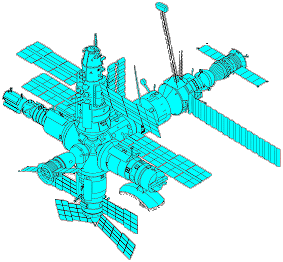 |
 |
 |
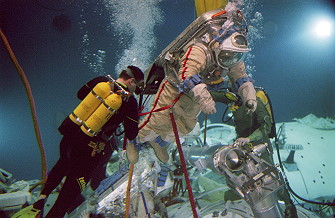 |
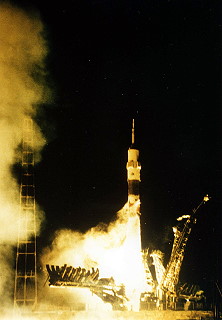 |
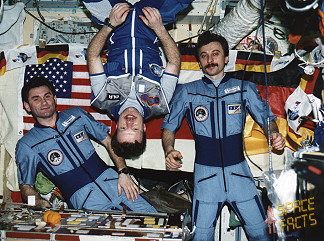 |
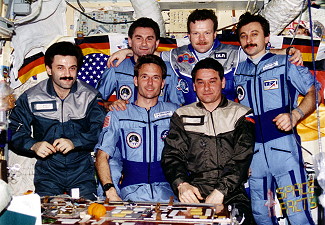 |
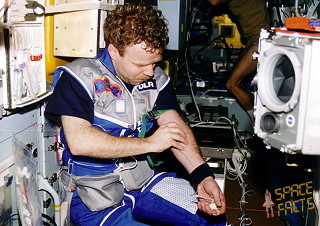 |
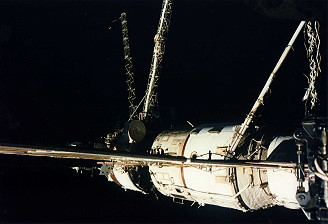 |
 |
 |
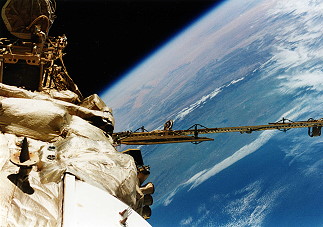 |
 |
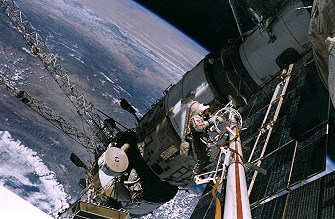 |
 |
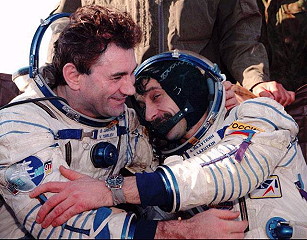 |
more EVA photos |
|
| © |  |
Last update on August 12, 2020.  |
 |